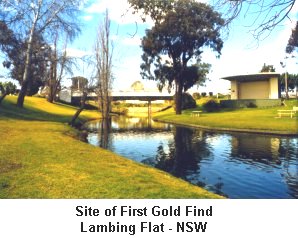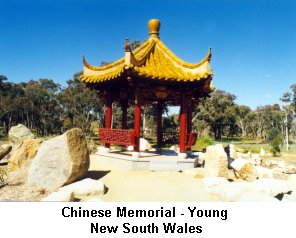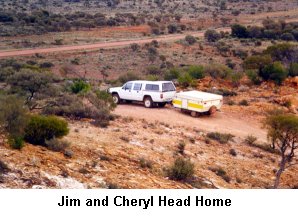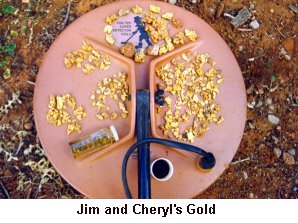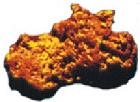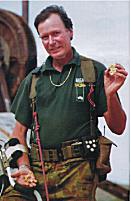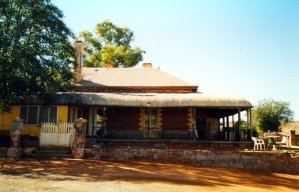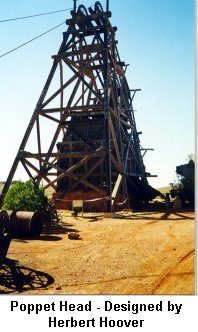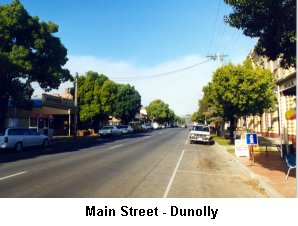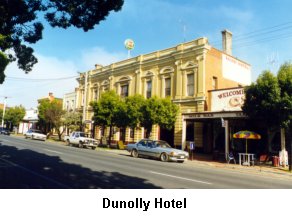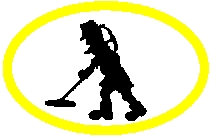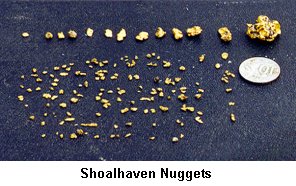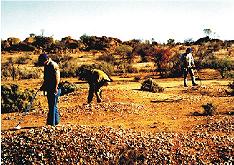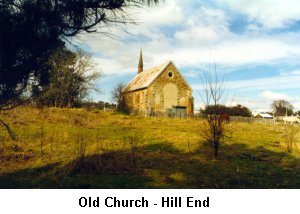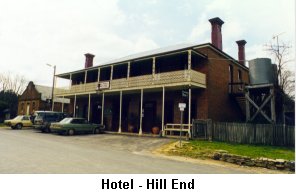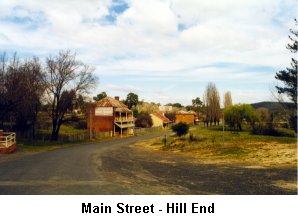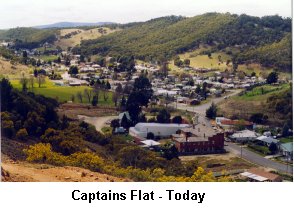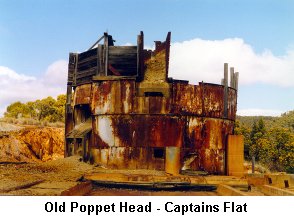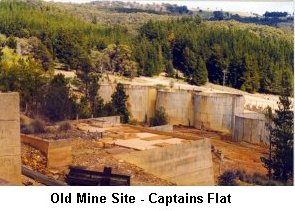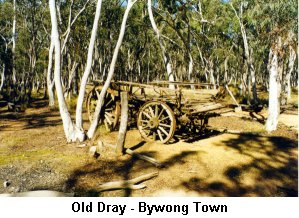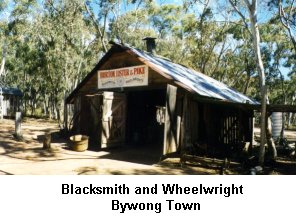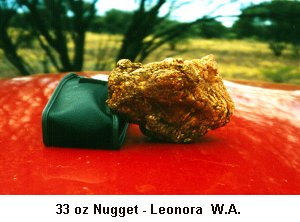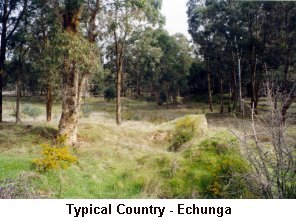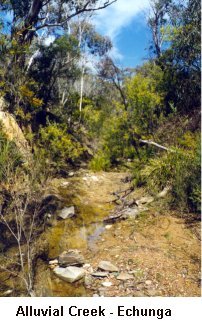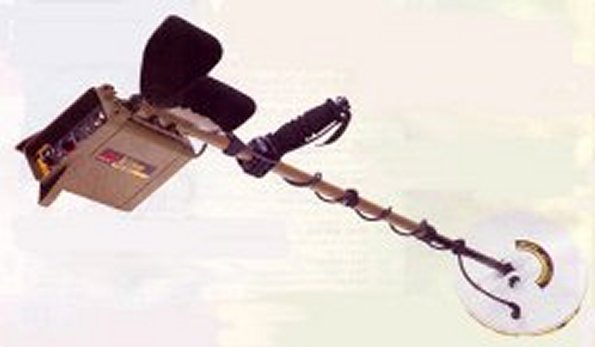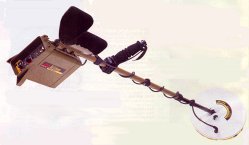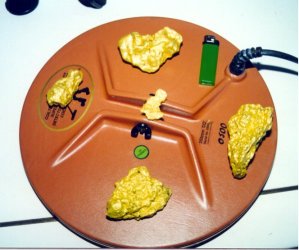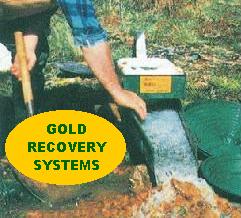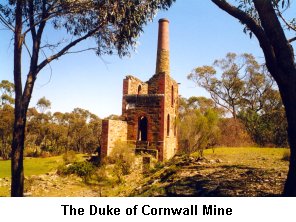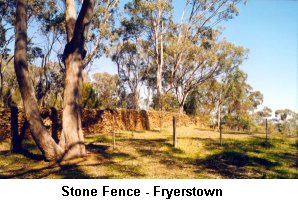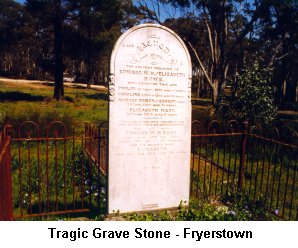
| October 1999 | |||||||||||||||||||||||||||||||||||||||
|
|||||||||||||||||||||||||||||||||||||||
Contents
|
|||||||||||||||||||||||||||||||||||||||
| 1. EDITORIAL In our July edition we confidently predicted that the price of gold would rise in the near future. We were right. We said, "Why the gold price remains low is open to conjecture, however here at Gold Net we believe that the rate is well below real value and will shortly lift rapidly to previous levels, and may even exceed those levels." The price of gold on the world market had been depressed for some time and all indications were that the price may remain depressed, while most western governments and banks continued reducing their holdings of gold. What has pre-empted the recovery is open to speculation and conjecture. Perhaps a realisation that the recent Dow Jones fluctuations with a bear run in the wind, may have stimulated previous traditional gold markets to rethink abandonment of the gold benchmark. Whatever the reasons behind the gold price recovery, it is a great relief to all involved in the industry world wide. Many of the larger players in Australia who had announced mine closures have in the main reversed these decisions. Financial markets in recent years have tended to ignore the ever secure value of gold as a benchmark indicator. Just why this has occurred is puzzling. Recognition of the gold benchmark provides stability to the fragile nature of world monetary markets. With this recovery we are hopeful that this point has been driven home to speculators. We look forward to a stable solid gold price in the future. Editor Email: [email protected] All material in this magazine is copyright and may not be reproduced in any part or form whatsoever without written permission from the publisher.
|
|||||||||||||||||||||||||||||||||||||||
|
2. THE LAMBING FLAT RIOT by Craig Wilson Lambing Flat, was named as lambing ewes on the extensive pastoral runs of Burramunda pastoral run, selected the area to drop their lambs. The obvious name resulted. The area had been a substantial rural holding for almost 30 years before gold was discovered in alluvial sands, in March 1860. The find was kept quiet for about 3 months, but by June word had spread and diggers were flocking to the area. The well-practiced procedure of calico tents and mean dwellings along with a main street of traders soon flourished. Lambing Flat had more than its share of radical rascals, with a history of debauchery, drunkenness and criminal activity. Additionally there was a radical element among the miners that ultimately was to lead to the great tragedy of the Lambing Flat riots. As the European miners moved in and took up the auriferous ground the Chinese appeared, as was their custom. The Europeans were resentful of the Chinese intrusion. They were considered to be evading their share of taxes and where most European's intended to build this country the Chinese had no intention of remaining or contributing to infrastructure. Their intent was to gather as much gold as possible and then return to China.
In November 1860 the Burrangong goldfield was proclaimed and a gold commissioner with three troopers arrived there. There were about 3,000 diggers on the field at this time, and when the police presence was established the Chinese flocked in. Lawlessness was rife and the troopers were unable to cope with the buoyant activity of some of the diggers. A vigilante group was established among the diggers and although this was illegal was to a degree tolerated. Punishment was harsh for those accused of stealing should they fall into the hands of the local vigilantes. What started out as a purposeful organization with good intent soon deteriorated with the moderate committee losing control, with a more radical group seizing control. Anti Chinese sentiment was fostered and this resulted in sporadic attacks on some Chinese. Pigtails were cut off, bashings occurred and some dwellings burnt. The situation was quickly out of control. Re-enforcements were called for and Captain Zouch arrived with eight mounted troopers and two detectives. They reported that all was quiet and they could find no dead Chinese. At that time the committee was firmly dealt with by the authorities and although no one was charged with any offences, the diggers were brought into line. All remained relatively quiet, although the simmering undercurrent of resentment continued until January 1861 when William Spicer and a few others who had arrived from the Adelong gold field stirred up trouble against the Chinese again. Spicer had been instrumental in agitating against the Chinese at Adelong. The vigilante group encouraged by Spicer and his cohorts passed a motion to drive the Chinese from the gold fields. The more sensible elements of the organization were drowned out and the group decided to take the law into their own hands and deal with the Chinese once and for all. The police were told that if they interfered their new buildings would be torched. Re-enforcement's were sent for from Yass and Inspector McLerie arrived with 30 police soon after.This small police presence among some 5,000 angry miners scarcely caused any concern for their actions and meetings were held all over the goldfields where Spicer, Allan and Stewart addressed them. It was unanimously decided to move the Chinese from the gold fields once and for all. The famous "Roll Up Flag" was made and a brass band assembled with 4,000 miners who marched to Blackguard Gully, where the Chinese numbering some 200 were put to flight. Some were beaten up, other robbed and almost all the tents and possessions were burnt. The police acting quite properly arrested several of the ringleaders and took them to the lock up. A large group quickly gathered and demanded their release. Next morning they were tried, found "Not Guilty" and released. Perhaps this was an act of conciliation on the part of the authorities but nothing was going to stop the diggers now. All Chinese servants and business people were chased out of town, some in fear of their lives. Several businesses closed to protect their property. On February 25th 1961 the government sent from Sydney 130 soldiers, a cavalry regiment and 3, 12 lb field guns with an escort of 20 mounted troopers. They arrived on March 11th. The State Premier Hon. C. Cooper arrived before the troops and addressed a number of miners meetings. Although he agreed that the Chinese were undesirable, he warned that they must not be molested in any way. He undertook to put their grievances to the Legislative Council in the capital. At this time he re-named Lambing Flat, Young after the Governor, Sir John Young. An uneasy calm prevailed over the area and assessments were made as to the likelihood of further trouble in the immediate future. The troops remained until May when they were withdrawn. Two weeks later word came from Sydney that the Legislative Council had rejected a bill to remove the Chinese from the gold fields. Additionally, it was reported that a further 1,500 Chinese had landed in Sydney and were on their way to the diggings. The "Roll Up" call went out and some 3,000 diggers quickly assembled at Tipperary Gully just north of Young. They marched into the town and towards the Chinese camp just south of the town. The police and mounted troopers were powerless against such odds. All their efforts to stop the mob were in vain. The diggers attacked with the band playing. Spread out on a broad front they moved running into the Chinese camp, catching some of the inhabitants by surprise bludgeoning and bashing them as they fled to the south. Those that were caught had their pigtails cut off and all of their possessions were smashed and burnt. Several drunken diggers on horseback rode into the fleeing Chinese, inflicting cruel wounds with bludgeons and whips. The attack was over in minutes. Once their object had been achieved the men re-assembled and marched back through Young, quite content with their handy work. The police arrested five of the ringleaders the following Sunday with the miners gathering to demand their release. A massive stand off ensued with the Riot Act being read and with shots being ordered fired over the unruly group's heads. The miners retaliated and returned fire over the heads of the police lines. The police charged the miners and in the ensuing battle William Lupton, who was fleeing the scene was accidentally shot dead. He was buried with full military honours by the diggers with their band leading the funeral procession. The police wisely abandoned their buildings fearing an all out attack that night, and withdrew to Yass. Before morning the new police compound had been burnt to the ground. Several of their leaders headed to Sydney to put their grievances to the government, but they were refused an interview.
A short time after the New South Wales Legislative Assembly passed the Chinese Immigration Restrictions Act laying the foundations for the "White Australia Policy" that remained well into the 20th century. Today Young celebrates the contribution made by the Chinese to the history of the area, with a memorial near Lambing Flat. The Young Historical Society proudly displays the "Roll Up Flag" that was preserved within the maker's family for over 100 years.
|
|||||||||||||||||||||||||||||||||||||||
by Jim Foster Time was running out. We had only two weeks left to find as much gold as possible before we would be forced to leave this magical country. Having made ourselves very comfortable we were reluctant to move camp, but this is one of the traps we recognized. Staying too long in one spot can mean disaster. we thought long and hard on where to go. We finally agreed to move camp onto the spot where we had found our biggest nugget so far. THE NEW CAMP We found our new camp was adequate, not as comfortable as the last one, but it did have good looking ground nearby. In fact we could walk straight out the door and begin detecting with a good chance of finding gold, and this is what Cheryl did. Just a stones throw from camp Cheryl dug a deep signal that turned out to be one of her best nuggets for the trip. We gave that ground a real hiding but could not find another nugget. OUR FIRST VIRGIN PATCH From our camp, which was on a low, tree covered hill, I could see a slope that dipped down to a dry creek bed. For some reason that slope called me. Why that slope I don't know as there were many areas that looked just as good visible from camp. Working my way down the hill and across the flat I crossed the creek and was astounded to find my first nugget exactly where I had felt I should look. It was only a small nugget but that didn't matter. A spot had called, I had responded and gold was found. Working slowly and carefully I searched for more. It didn't take long. By the time I had five or six nuggets a pattern was emerging on their distribution. Taking a chance I headed up the shallow slope to where several fist-sized lumps of quarts showed above ground. S winging the coil over these my guess was confirmed by the presence of another nugget. The gold was being shed from a small leader reef, the quartz rocks being the only surface clue to its existence. Using this information I quickly cleaned up the remaining nuggets from the patch. There were only a total of eleven nuggets the biggest being only four and a half grams. Chaining the spot later confirmed I had found all the gold there, but the location of that little reef remains in my head. CHERYL'S PATCH While I had been busy cleaning out that patch Cheryl had also been busy. Not more than fifty yards from camp she had discovered the first nugget of yet another small patch. This patch was spread over a low ridge and into a very pretty little gully. It was nearing spring and wildflowers were everywhere, adding patches of wonderful colour where ever we looked. Digging nuggets is fun but digging them amongst wild flowers is an added bonus. On this larger patch both of us could participate and we both found nuggets where ever we looked. Again the flow of nuggets soon revealed a pattern. We found another small leader reef was shedding the gold and again once we found this it was easy to mop up the remaining nuggets. With two small virgin patches under our belts we were keen to find more. Tramping miles of great looking ground we found only widely scattered nuggets. This was frustrating. A nugget would be found and we would concentrate on the surrounding area only to find nothing. After a few days of this we decided to move camp to our last camp of the trip. The spot we picked was a well known detecting spot that had produced thousands of good nuggets over the years. Being so popular we expected to be camped near other prospectors for a change. BACK TO CIVILIZATION Packing up we drove across to Deep Well a bore with a windmill and tank that we knew produced good water. Topping up our water supplies we moved on to Murrin Murrin, our new campsite. Picking a site close to the main track and where many people had camped before us we settled in. ANOTHER PATCH Beginning our detecting close to camp I found a nice nugget right beside the track. Thinking it was only a stray nugget missed by all the previous searchers we thought little of it and continued to search further afield. It wasn't until Cheryl was returning to camp that more gold was found. Arriving back near the camp I noticed Cheryl concentrating hard on a small area, by the time I got there she had four nice nuggets. We were astounded. The patch began right under our ute, crossed the track and continued up the slope for about twenty yards. As it was Cheryl's patch I left her alone to concentrate on it without any distractions. Working slowly and carefully back and forth Cheryl just kept right on finding nuggets. Some were only very small and not very deep. Others were larger and right down on the cap-rock, nearly a foot deep. Cheryl was having a great time. Strangely enough there was a lot of rubbish around but very little on the patch itself. OUR FIRST VISITOR We were relaxing from the heat of the afternoon when we heard a vehicle coming. Soon we saw a utility heading our way. It stopped in front of our camp and we had our first visitor for some weeks. I glanced past the vehicle at out patch. I had placed pink marker pegs at the corners to the patch to help with chaining the area, these were plainly visible but our visitor didn't seem to notice. The newcomer turned out to be a nice fellow and we had quite a long chat. As he left he saw the pegs but made no comment. As the day cooled we went back to work. Now Cheryl was working one side of the patch while I gridded from the other. Using the larger coil I was mopping up those smaller, deeper, nuggets that Cheryl's smaller coil had missed. It took until the end of the next day to be sure we had missed no gold. By then we had a total of thirty-four nuggets that weighed all up just over an ounce and a half. LAST DAYS Our friends from Kalgoorlie came to visit for our last two days on the goldfields. It was hard to believe our trip was almost over but we had two days to go and who knows what we might find. It takes only one swing of the coil to find a nugget, big or small. Saturday blew in on a bitter wind from the west. This was the coldest day for the trip. Not for the entire day did we remove our coats. Brian and Mags joined us by mid-morning and were soon hard at it not far from camp. A few small nuggets turned up that day and I was pleased that everyone got at least one. Despite the cold we had a campfire that night and sat talking over the highs and lows of the trip and our immediate plans.
IN CONCLUSION Our trip lasted just on four months. Overall the weather had been wonderful with only two days lost to rain. Our Minelab SD2200D Gold Detectors had performed superbly. Our vehicle was faultless and our bold little camper trailer had gone everywhere we asked it to with no bother at all. We had learned to navigate in remote areas using compass, map and GPS with pinpoint precision. We had found gold and beauty where ever we went. We had learned we could live together in a tiny camper for months at a time and grow closer while doing so. And we could find gold in Western Australia. Our dreams of gold were fulfilled, we were content as we drove south, already making excited plans for next years trip to the Golden West of Western Australia.
by Katherine Knight Anyone who has an interest in gold mining companies will have seen the name Sons Of Gwalia listed on the mining section of the stock markets of the world. What intrigued me for many years, and many others, I am sure, is how this name came to be. The Sons Of Gwalia mine is situated in the eastern goldfields region of Western Australia. It was found by a group of Welsh prospectors in 1896. Gwalia simply means Wales, hence it was sons of Gwalia who found the mine. But finding the answer to a question that had intrigued me for years was only the beginning. HERBERT CLARK HOOVER 31st President of the United States H.C.Hoover was a mining engineer of only twenty-three years of age when he was appointed as a consultant for an English company Berwick Moreing. They were acting as agents for clients in Western Australia for ten Australian gold mines as well as many prospecting sites. With enormous amounts of money at stake they required a man of experience. As the work was strenuous, a younger man, a man they thought who should ideally be around the age of thirty-five years.
DESERTS AND DESOLATION Arriving in Western Australia Hoover found that inspection of the mining properties meant days on end on camel back. Camels were the only form of transport that could stand the vast waterless distances where the only ground cover was a low scrubby sagebrush. Little shade could be found from the blistering sun beneath the sparse cover of the twisted and stunted mulga trees. Indeed, when seated on a camel's back the rider was most often higher than the trees themselves. In temperatures where in summer the mercury rarely dropped below 100 degrees F, Herbert Hoover travelled as far as thirty or forty miles in a single day. Here he met the indomitable Australian gold miner, that rare breed of men who live on hope and not much else in an arid, waterless wilderness, endlessly prospecting and hoping for that big strike that would take them out of the heat and loneliness of the bush. These men ranged over a land as hostile as any place on earth. A place where water was often more precious than gold, for gold was often more plentiful than water. Strangely enough many of those who did strike it rich returned again and again to that world they had striven so hard to escape. HOOVER FINDS GWALIA On one of his camel treks Hoover camped near a prospect a group of Welshmen had named Sons Of Gwalia. The Welsh syndicate had sold out to a G.W. Hall for five thousand pounds. Hoover was shown through the primitive mine. It was nothing spectacular. A lone shaft that was down 175 feet with several hundred feet of drives to the lode. The main reef dipped uniformly and maintained its grade with depth. There was a parallel reef in the formation with good values in the host rock and most important 40,000 tons of ore proven.
THE BUILDING OF GWALIA In less than a year Herbert Hoover laid the foundations for a gold mine that was to produce gold in an almost unbroken stream for over one hundred years. He implemented radical changes in the way the ore was mined. He designed and had built of termite resistant Oregon timber the poppet head that still stands today as a legacy of his energy and vision. To date the Sons Of Gwalia gold mine has produced nearly five million ounces of gold. GWALIA TODAY The mining entity that is the Sons of Gwalia continues on. The original underground mine was closed in December 1963. In 1984 open pit mining commenced. This operation came to a conclusion in 1999 when underground mining recommenced. When the mine closed in 1963 an entire town was out of work. Many families walked out of their homes and out of the town of Gwalia. Derelict miner's cottages fell into disrepair. Shops and business's closed or moved to nearby Leonora. The hustling and bustling town that was Gwalia soon became a sad little ghost town. Then residents of Leonora began to take an interest in their fading neighbouring town. Soon Gwalia began to bloom again as efforts were made to repair the miners' cottages to their original condition. A museum was opened and the house where Herbert Hoover once lived made presentable. The old wooden poppet head that Hoover designed and had built, along with the winding gear, was moved to the present site next to the museum overlooking the immense hole of the open cut mine. To visit Gwalia today is to step back in time. From touring the museum and town or to just gaze out over the surrounding dust-dry countryside is to begin to appreciate how hard the old timers did it in what is now known as the Golden West.
|
|||||||||||||||||||||||||||||||||||||||
|
|||||||||||||||||||||||||||||||||||||||
|
|||||||||||||||||||||||||||||||||||||||
|
|||||||||||||||||||||||||||||||||||||||
|
5. DUNOLLY GOLD Sue "Goldie" Reynolds If the privateer is looking for the most favoured place for metal detectors in Victoria, Dunolly would rate very highly on the list. Even after 150 years of pouring forth grand golden nuggets, one still hears of good nuggets being found in the Dunolly area. I have seen a few of these, up to 10 ounces myself, but I am aware of several in the 20-30 ounce range. It was recently reputed to have produced a nugget over 450 ounces, but the details are being kept secret for obvious reasons, and I could not confirm that the story was accurate.
A large number of huge nuggets have been found here. Listed below are just some of the nuggets and the area in which they were found.
It should be recognized that this is by no means a comprehensive list of nuggets found in this area, but a representative example of the enormous wealth that was locked in the ground around Dunolly. There are substantial records of nuggets ranging from 1 ounce up to 100 ounces, in enormous numbers. Gold was first found at Pattersons Gully, Dunolly in 1853. It was referred to as a nugget field in view of the large number of nuggets that came from the ground here. It was not however a prolific producer of gold in the area. There were many more successful areas that produced substantially more gold per ton of wash dirt. The most successful returns were in the vicinity of 287 oz from ½ ton, 309 oz from 1 ton, and 602 oz from 2 tons. The auriferous gold in this area could be described as thick, dense or plentiful, all these descriptions are accurate. Although large quantities of gold were found near the surface, good gold was recovered at depth. Several reefs were followed underground and many shafts were sunk to gain the gold. The area had at times up to 35,000 diggers on various diggings, with specific rushes seeing initial flushes of up to 15,000 diggers flooding to the new diggings. The most successful rush occurred in 1856 when the Old Lead was rushed and 35,000 diggers arrived. The Main Street of Dunolly was some 3 miles long and was known as Broadway. The traders, many and varied did a roaring trade. It was a prolific producer of large nuggets, up to 1,218 ounces. At least 27 known nuggets were over 100 ounces. Just how much gold was produced from this area is open to conjecture as records are scarce and the vast majority of gold was recovered before records were kept in any detail. It would be fair to state however that several tons of gold was recovered from the Dunolly area.
At the Hard Hill Rush there were about 7,000 diggers, and a large rather scattered hessian town existed here to service the needs of the diggers. With the rush to the Old Lead the entire town shifted to the present location of Dunolly and more permanent structures were soon erected. Today Dunolly is a sleepy little hamlet that still has two hotels, and a general store along with a modern motel and several other shops servicing the town. There is a large caravan park that is well supported, particularly by fossickers. The population of the town is about 1,400. Many of the locals detect the area with some success. The town has a number of professional prospectors. Dunolly will continue to give up its gold. It has been and will remain a mecca for gold enthusiasts.
|
|||||||||||||||||||||||||||||||||||||||
|
|||||||||||||||||||||||||||||||||||||||
|
6. THE HALF TIME DIGGER David Foreman You will find professional prospectors all over the gold fields of Australia. By professional, I mean those characters that essentially live wholly on their ability to extract gold from the ground and upon which they rely for their livelihood. I had heard of Ray Gough and his reputation as a man who could find gold easily. Basing himself along the Shoalhaven River in New South Wales just south of Sydney, I took the opportunity to seek him out and spend some time with him. Arranging a meeting through Martin Marks, I arrived at the Shoalhaven and met this crusty character. A man of relatively small stature, with a weather marked face, etched with the lines of wisdom and knowledge. He was a rather jolly fellow, pleasant to talk with and knowledgeable. He was having difficulty with his floating sluice, as a pontoon had sprung a leak, and was slowly sinking. In any case, his day sluicing was done and he retired from this activity and spent some time talking with me.
Ray had grown up on the south coast of New South Wales, at Nowra. He had served some time as a soldier during the Vietnam War. He had been married once and has three children, who are his pride and joy. The marriage was now a forgotten dream, and these days he spends his time prospecting for gold during the winter months and during the summer months he concentrates on a bee keeping enterprise. We spent the rest of that afternoon doing a lot of talking about gold and how and where it was found in this region. I kept my wits about me and listened intently to what was being disclosed. Men like Ray are invaluable to gain knowledge from. Some are very secretive, but Ray was a true gentleman and disclosed his knowledge willingly. I was so fascinated that I wanted to stay longer. Ray was, at the same time, picking my brain on the latest detector coils. I had some experience with the latest and most advanced detector coils and I had them with me. Consequently it was arranged that in a couple of days time, we would again meet and on this occasion take to the bush and go detecting. Ray was camped in the bush, well off the road and out of site. I had been given detailed instructions to this location, and they were accurate to the last detail. I too had been a soldier in the Vietnam era, and we sort of spoke the same lingo. (language) The camp was simple but effective. A caravan, with a tent annex, with a spot for a fire, not too far from the river, but certainly far enough away to protect the gear from a flash flood. There was even a clothesline. We talked again for a while before setting out in his rather old and bush worn ute. The site he had chosen was just a couple of miles from camp. The day had started out rather chilly, but as the day progressed, the warmth of the spring sun was really appreciated. We stopped, just off the main track and in a position that the vehicle was hard to see from the road. Decking up with our gear, we trudged off into the bush. After about half a mile we came across a creek bed. It was almost dry, with only a few stagnating pools of water left. However, it was here, Ray explained, that he had got some good gold previously, and that although this area had been well detected before, he was still getting gold. To avoid interference between his detector and mine he moved off first and I let him get about 100 yards ahead of me before I moved off too. The creek had very steep slopes, and was covered with unfamiliar bushes that had sharp spines attached. I almost immediately hit targets. Unfortunately, they were decaying ferrous. The odd button here and there, and an old nail or two were dug up. All evidence of old timers being there and getting gold over 100 years ago. It was tough going up along that creek. I had the added load of all my good camera gear, and I was a little slow keeping up the pace at times. However I wanted to detect this ground thoroughly and learn about gold in this area, as I had not detected this country before. I was using a Double D coil, but the country was not particularly hot, and I perhaps should have been using a mono, as it would have been more suitable. That was back in the ute and I wasn't going back for that. Undeterred, I soldiered on. The creek itself was not as productive as I had imagined. Then, I always imagine picking up large nuggets. That's what keeps me coming back. Both Ray and I picked up a few small nuggets along the creek, but it was hard going and the prickles both on the bushes and in the ground were there in their millions and my hands and arms were being continually torn at. Never the less we continued along that creek for about a mile before we both decided there had to be easier ground to detect. For our efforts we had only a few small nuggets. Still we were getting gold, and one becomes rather tenacious when one is getting into the yellow stuff. Ray suggested we walk cross-country to another gold field he knew that was still giving up some gold. We walked for a long time, chatting as we pushed through the bush up hills and down rather steep slopes. These diggings were well hidden, and were in fact still along the creek line but miles from where we had started. This ground was clearly auriferous. It was highly mineralized and I was glad at that point that I had the DD coil with me. The patch was extensive and had been worked seriously up until the 1930's before being finally abandoned. This was serious gold country and we both stepped off in opposite directions and started detecting. We hit pay dirt almost immediately. I got good targets immediately and picked up quite a few small nuggets pretty quickly. Ray was doing the same and he was getting about the same amount as I was. We were both pretty happy with the events and although the digging was hard in this ground, it was rewarding.
I knew it was good news so I walked over to him. His grin was from ear to ear, and that rough worn face was well alight with joy. "Take a look at that mate" he said, holding out a nice half ounce piece of quality gold. It was a real beauty. Solid and neat in appearance and well worth the 9" he had to dig to get it. We both took some time out and talked for a while. It's a great feeling when you get gold and especially when you get a nice piece like this. Ray's joy was clearly evident and his demeanour changed for the rest of the day. He could hardly contain himself, and I was really pleased for him. We continued for about another hour still getting some small nuggets. I tried for a big one as well, but for one day our luck had been pretty good. Calling it a day late in the afternoon we made our way back to his ute and then to his camp where we looked over the nuggets. Our day had been incredibly successful. We had clearly hit a good patch that had not been detected before and the rewards were pretty good. We enjoyed a cuppa (tea) and after a good chat, dividing up the spoils equally. I had thoroughly enjoyed the day and made arrangements to return as soon as work commitments would permit. The day was indeed a success. I had picked up some good gold and had gained a new friend.
|
|||||||||||||||||||||||||||||||||||||||
|
|||||||||||||||||||||||||||||||||||||||
|
|||||||||||||||||||||||||||||||||||||||
|
7. HISTORIC HILL END by Brian Trumble Hill End is situated at the end of a dry and dusty road some 40 miles north, north west of Bathurst, New South Wales. It is now simply a tourist village with a heritage of gold that is second to none. The area is well preserved and the locals fiercely defend the heritage of the area. The greatest claim to fame of this historic town is the Holtermann Nugget, That great single piece of quartz, slate, mundic and gold ever mined, anywhere in the world. It contained about 2,750 ounces of gold. This great piece of history was blasted out of the ground on October 19th, 1872. The mine was owned by a company at the time, with the three previous principals, Beyers, Holtermann, and Kerr, having sold the major share of the Star of Hope mine, some months before. They did however retain a share. Holtermann was photographed with the nugget and for this he has become famous. Gold was first found at Hill End in 1851, and was a substantial alluvial gold field. For 20 years the gold field produced well, with quartz reefs being uncovered from time to time and this led to a large scale boom in 1871-72. As the fame of this region spread worldwide many diggers came from overseas to find their fortunes, and many did. It was here that the head of the great coaching empire, Cobb & Co. had its headquarters and James Rutherford, the man in charge had a grand mansion from where he directed the operations. In distances travelled Cobb & Co. in Australia, out rivalled Wells Fargo of the USA.
The surrounding gullies roads and steep slopes have a myriad of stories locked into historical fact. Monkey Hill, named as one almost had to be a monkey to climb it, is reputed to have it's own ghost. A man called Timothy Halpin was thrown from his horse and killed one night in 1872. He is supposed to wander the hill nightly in search of his horse. At least that's the story the locals tell. And who am I to disbelieve a local? Another fine story is of Mrs. Carroll's sly grog (illicit liquor) shop. She would keep the stock in trade tied to string and held down a well at the rear of her house and when interfering troopers would approach, she would cut the string and let the grog float in the water below until the troopers had gone. She was only successfully prosecuted once, and that was because an informer notified the police. It was entirely co-incidence that the informer was severely beaten up the next day, or so the locals say. At the peak of the rush there were 28 hotels in the town itself and over 70 in the surrounding area. Only one remains today. Because of the steady gold stream coming from Hill End the shops were many, and the town well established. There were blacksmiths, general stores, coachbuilders, chemists and millinery emporiums. Many grand churches were built but these are now mostly destroyed. Hill End was in fact a grand, vibrant, and wealthy town.
Tambarooma was a small town some 3 miles from Hill End and was itself a great golden gift with many quality nuggets being found here. All of these towns have legends and perhaps the most engrossing is of an old "souse" called Polly Gratten who upon wearing out her welcome at the local hotels was attempting to walk to Hill End from Tambarooma one night in a rather pickled state. Feeling the need for rest she lay down in the graveyard to rest behind a large headstone. In the meantime the town practical joker, Billy McCudden, decided to take a rise out of a group that he knew would be walking home from a concert at Hill End. Donning a white sheet he crept into the cemetery and lay in wait, unaware of Polly's presence. In due course when the group arrived he leapt forth, raised his arms and called out "Arise, ye dead, and come to judgement". Polly, upon hearing this raised her drunken self up on the headstone and called out, "Yes Lord, I come". The entire group including Billy bolted for the town some quarter of a mile away with poor Polly staggering along in hot pursuit. It was stated that Billy passed the entire group before they had gone the first hundred yards. When Polly finally staggered into town, she was so sure she was in fact dead that she woke up the undertaker and demanded that he take her measurements. It is reputed that Billy's career as a practical joker ended on this night. The ever present Chinese had a large camp at Hill End, numbering some 1500. As was the custom with all Chinese they kept to themselves, built their own Joss Houses and had their own shops. Whites avoided the area and there were occasional clashes between the two groups. Although there was originally a large Chinese cemetery at Moonlight Gully those interred there have since been dug up and their remains returned to China, to be close to their ancestors as is their custom.
The most famous golden area is Hawkins Hill. A grand monolith that gorged forth huge quantities of gold. It took the diggers seven long years to gain the wealth from Hawkins Hill, and this was not helped by Holtermann who wrote to the Sydney papers, suggesting that there was no gold there. His effigy was burnt in protest. Even today some prospectors still ply their trade here, eking a living from this once grand golden place. Just how much gold was taken from Hill End is as usual, open to conjecture, but in one week alone over a ton of gold was escorted to Bathurst and on to Sydney. Hill End was a grand producer and provided a handsome income for many years, both for the alluvial privateers and the deeper reef mining companies. The history at Hill End is almost endless. To detail the history of Hill End in such a short article is an impossible task. Albeit to say that a visit to this historic township is a rewarding and enlightening experience. It is recommended that if possible at least two or three days would be required to successfully explore the area.
|
|||||||||||||||||||||||||||||||||||||||
|
|||||||||||||||||||||||||||||||||||||||
8. FLECKS ! - Glints from here and there
|
|||||||||||||||||||||||||||||||||||||||
|
|||||||||||||||||||||||||||||||||||||||
|
9. CAPTAINS FLAT by Lou Garland Nestled in the cool folds of the lower slopes of the Great Dividing Range, about 40 miles south east of the National Capital, Canberra, lies the small hamlet of Captains Flat. To drive through this small township one could be forgiven for wondering what prompted people to live here, but tucked away mainly out of site lies a wealth of history, second to none in this fresh cool country. Just how Captains Flat was named is a mystery. The locals still argue about the origins, with a number of legends and possibilities being put forward. It may have been named after an old sea captain, or a landowner that used the term Captain, who in fact turned out to be a Private. It may have been one of the owners of the surrounding sheep runs, but the story I like best is as follows.
Gold was first found in this area in a freshly dug grave, near the town sometime in the 1860's, but nothing came of that find. The owner of the land simply utilizing his knowledge and digging the gold for himself. However in 1864 a shopkeeper displayed a sample of gold, found by a boy. Undoubtedly the shop keepers intent was to create a stampede for the gold thus enhancing his business. Incredibly this did not create the rush that was expected either, and although some prospectors were in the area, the area was not rushed. It was not until prospectors travelling to the Cooma gold field stopped there in the 1860's and took some gold that the area became alive with prospectors. There was not a large influx of diggers into the area at this time, but interest and activity increased.
Other metals were known to be in the area. Copper, Lead and Silver were prominent. When gold was found in recoverable quantities in September 1882, the area was rushed, at last. By this time large companies were operating the leases, and Bernard Holtermann, (who discovered the Holtermann Nugget at Hill End) bought into the company and provided a 10 head stamper driven by a 20 horse power engine to crush the quartz.
During 1884-5 despite trying times the mines stayed open, but now the attention was turning to lead and silver. The real golden era of Captains Flat came from lead and silver and not gold. . Several mining companies operated in the region, some with outstanding success, but there were failures as well. The El Kapitan Mine in 1888 was taken over by the great, Broken Hill Propriety Company, but even with their expertise the ore resisted treatment with the technology available at the time. Between 1887 and 1899 Captain's Flat mines produced 205,707 tons of ore. The yield was 806,795 ounces of silver, 16,140 ounces of gold and 3,781 tons of copper. The future looked certain for Captain's Flat. The population had reached 3,000 and the town was booming. The last decade of the 19th century looked secure. At its peak the town had six general stores and five hotels. There was also several businesses including a jeweller, two dentists, a chemist, three hairdressers, a tailor, a blacksmith, a billiard hall and a newspaper.
The town had three distinct suburbs that still apply to this day. Bogtown, to the north, Newtown towards the centre of the town, and Coppertown to the west of the mined hill. It is amazing that the first government building in the town was the police station, and that was not erected until 1886. The present police station although a newer structure remains on the same piece of land. There was a racecourse of sorts and an Australian Rules Football team. It is recorded that one of the footballers representing the Captain's Flat Rovers Football Club went 18 rounds with a professional boxer before a local police officer stopped the fight. He must have been a tough man, as he reputedly came out smiling every round.
At the turn of the century as the mines closed, the town's population was over 2,000, but within a few days had declined to less than 300. Despite the remaining townspeople being positive that the mines would re-open the town remained a desolate and forlorn place. In 1937 a survey company estimated the recoverable reserves at Captain's Flat at 5,000,000 tons. The Lake George Mines Company commenced operations in January 1939, and the railway reached the town in September of the same year. With the outbreak of world war two, the European markets crashed, leaving only available markets in the U.K. and the USA. To keep the ore moving the government granted large concessions to the company allowing the mine to continue operating. The mine employed 550 men at this time. A period of prosperity continued until March 1962, when the mine closed. Diminishing markets and a lack of ore were the main reasons for the closure. From that time on the town has continued it's economic decline. With a population of about 480, the town still had a strong heart. It is surrounded by auriferous country that probably has yet to see a detector. Captain's Flat may yet hide wealth that has yet to be discovered.
|
|||||||||||||||||||||||||||||||||||||||
|
|||||||||||||||||||||||||||||||||||||||
|
WE BUY GOLD GOOD QUALITY NUGGETS REQUIRED TOP PRICES PAID Currently seeking half ounce nuggets and upwards. Gold nuggets sold on consignment 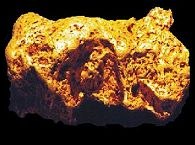
PO Box 258, TANUNDA. SA. 5352 Mobile: 0417 848 910 E-mail: [email protected] |
|||||||||||||||||||||||||||||||||||||||
|
|||||||||||||||||||||||||||||||||||||||
|
10. BYWONG TOWN by Peter Liddy The national capital, Canberra is a fine modern city with a population of 300,000. What is not well known about this area is that the area around Canberra has produced more that a few ounces of gold. In fact right near Parliament House itself gold has been recovered. Gold had been found in recoverable quantities at Fairfield, Bywong, Brooks Creek, Woodbury and Jerrabiggery. Other deposits were found at Brindabella, Michelago and Queanbeyan. All within a stones throw of Canberra itself. Bywong Town is about a half-hours drive northeast from Canberra. It is easy to miss the signpost into this little enclave. The town is being carefully restored and the private owners are reconstructing the golden era of yesteryear. To get to Bywong town, take the main road from Canberra to Sydney. Turn right at the Bungendore Road, and only a few miles down this road there is a small signpost at Millyn Road, indicating Bywong Town. A short distance up this road there is a sign indicating the town is to the right. The road looks like a private track, but only a short distance up this track you will find the town.
In December 1895 a surveyor laid out the village of Bywong into four streets. Burbong, Bungendore, Burra and Gundaroo Streets were the selected names. Conditions were harsh. Times were tough and most of the diggers occupied mean dwellings constructed of hessian or canvas. Some dwellings were constructed of rough-cut timber from the local forests. Water was scarce, and there was always a constant battle to keep the town supplied with sufficient water. A school opened in 1895 with about 20 students. It closed in 1906. A general store and post office existed until 1904. By 1906 the gold was scarce and the gold field was almost totally abandoned. In March 1896 the government responded to the permanent need for water and commissioned three Chinese well diggers to construct a deep seepage well. This well is still in place and is in the same condition as it was when originally constructed. Unfortunately the well was not a success as there was a prolonged drought from 1895 until 1908, and the water table was well below the depth of the well during these years.
In an attempt to re-locate the reef, the government financed an exploration shaft down to an estimated 160 feet without success. It is unlikely that the shaft ever reached that depth as the supervising warden was afraid to enter the shaft and the diggers apparently failed to dig as deeply as they should have, disguising the true depth from the warden. In 1900 a family named Cronk, (later they changed their name to Shepherd), moved into the area. There were 10 children and their mother had recently died in Sydney and with their father, the two oldest boys aged 16 and 11 re-timbered the main government shaft when they discovered the header or dolly veins still contained considerable gold. The father fashioned a small hand operated stamping mill that effectively recovered quite substantial amounts of gold. Cronk eventually left leaving the oldest boy to support the family. When the law investigated the neglected children they found they were well looked after, fed and clothed, all from the proceeds of the gold. Their futures were secure.
Today the area is being redeveloped as a tourist facility, concentrating on school children. Over 10,000 students visit the site each year and this number is expected to increase as the site is developed. Reconstruction of mean dwellings, shops and other mining facilities continues. The village itself consists of a main street, a picnic area with toilets, which ironically, still displays the lack of water at the site. A blacksmith's shop, panning area, the well, and a number of buildings have been reconstructed. Sign posting is good with well-constructed paths throughout. The Mining Compound displays a large open cut area with the Aid Shaft, a hand operated battery and the stamp mill. It is indeed an interesting place, and one that is well worth the entry fee to visit what is still a primitive place, and one that closely resembles a gold mining town as it was over 100 years ago in the Australian bush. The facility is open 364 days of the year. It closes on Christmas Day. It is open from 10am - 4pm, with guided tours at 10.30am. 12.30pm. and 2pm daily. Records indicating just how much gold was taken from Bywong are fragmented, but it was not a significant amount. It certainly provided a living for the majority of diggers who worked the field for a few years. Perhaps one day the reef will again be located. Now that's a challenging thought.
|
|||||||||||||||||||||||||||||||||||||||
|
|||||||||||||||||||||||||||||||||||||||
|
|||||||||||||||||||||||||||||||||||||||
|
|||||||||||||||||||||||||||||||||||||||
|
11. STRIKES Recent Finds
|
|||||||||||||||||||||||||||||||||||||||
|
|||||||||||||||||||||||||||||||||||||||
|
|||||||||||||||||||||||||||||||||||||||
|
|||||||||||||||||||||||||||||||||||||||
|
12. ECHUNGA - THE OVERDONE GOLD FIELD by Adrian Cavanagh Echunga is situated about 20 miles south east of Adelaide, the capital city of the State of South Australia. It is a small community of some 1,200 people. The surrounding rural areas are now mostly hobby farms of a few acres. The State of South Australia was founded by free men in 1838, and it was only 13 years later that major gold finds in New South Wales and Victoria precipitated an avalanche of men to the gold fields, from all over the world. South Australia was no exception and at least 16,000 able bodied men deserted the new State in search of their fortunes. In early 1852 gold was found at Chapman's Gully, near Echunga in the Adelaide Hills, along the fertile flats of the Onkaparinga River. It was not a major find, but was sufficient to inform the authorities, as the government had offered a reward of 1,000 pounds for a payable gold field in the State to hopefully reverse the disastrous exodus of able bodied men from the fledgling State. William Chapman and his father found the gold, and when Chapman senior reported the find, his claim was greeted with great skepticism, although he had about 7 ounces with him. He was made to swear an affidavit that the gold had indeed been found in South Australia, when he made the claim at the treasury. The next morning they returned to the area in company with the Colonial Secretary, Finniss and a large party of mounted police and accompanied by about 40-50 horsemen, eager to witness the event. Chapman was commanded to take off his coat and roll up his sleeves to ensure authenticity. His was surrounded by a large group of excited onlookers when he washed his first dirt. There was not a scrap of gold in the bottom of the dish. The expectant hordes reacted strongly, with "Lynch him" and "String him up" being called out loudly. Chapman calmly filled his dish again and washed the dirt.
This "rush" in fact turned out to be a non-eventually only 80 licences were issued in the first few weeks, although within 2 months there were an estimated 600 people on the diggings. Echunga was on the main route to Victoria and at that time was at the peak of excitement over the enormous gold finds that were being discovered almost daily. Many of those passing through the diggings stayed for a day or two to try their luck, but in general the returns were less than encouraging, and they quickly moved on through Strathalbyn towards the great gold fields to the east. A small village soon sprang up near Chapman's Hill, and a number of stores were erected, the owners expecting solid returns for their efforts. The 130 tents interspersed with rough hewn timber dwellings were supported by a large array of stores and services, far too plentiful for the 600 -700 souls on the gold field. There were blacksmiths, butchers, bakers, hotels, chemists, draperies and other assorted traders all open for business. The returns from the gold fields were only ever described as moderate at best, with the largest nuggets being just over 4 ounces. Many of the diggers were not even making sufficient to purchase food, although some finds were encouraging. One party recovered 52 ounces at a depth of 6 feet. The wash dirt in general was between 6 and 12 feet below the surface. After two months of operation 684 licences had been issued, but apparently there were a number of diggers operating without licences. When police arrived and warned the diggers they would not tolerate digging without a licence the number of licences issued rose to 1,000. An estimated 5,000 ounces were taken in the first three months. This was the official figure and does not include what was taken away privately. It would be fair to assume that the figure was almost double the official figure.
With such meagre returns the diggers petitioned the government to reduce the 30 shillings a month licence fee without success. However, as returns reduced, the number of diggers reduced accordingly, with many moving to the great gold fields of Victoria, 400 miles to the east. More than a year later, further discoveries were made in the area at Long Gully, west of Bell's Hill. As this gold was located some 30 feet underground encouragement was need to recover this gold and licence fees were reduced to 10 shillings a month. The rush was immediate, and over 500 people were at the "Christmas Rush" diggings. The results from this rush varied wildly. The best returns from here were up to 12 ounces to one bucket of wash dirt. In general though most diggers struggled to make a moderate wage. This rush only lasted about 6 weeks, and with gold discovered at Forest Range some miles to the north of Echunga, the gold field was almost deserted by December 1852. It was worked until about 1855, when all serious worked ceased. The over supply of traders that existed in the initial rush had dispersed, with substantial losses to many. In 1858, a small rush occurred at Poor Mans Hill, after a government subsidy was provided to support the diggers looking for payable gold in the area. Further attempts to recover gold were made by companies at various times in the late 1800's, without success. In the great depression of 1930, the ground was again worked with little or no success. In total it is estimated that the total returns from this gold field were about 100,000 ounces. Perhaps the most outstanding feature of these gold fields was the orderly way people went about their business. Crime was minimal, and thefts rare. Debauchery was unheard of, and drunken behaviour was not tolerated. This may have resulted from the fact that this fledgling colony was of free men and woman, with none of the convict element that contributed to the lawlessness in New South Wales and Victoria. Part of the old alluvial ground is still under the control of the South Australian Department of Mines and Energy, and a small area has been set aside for gold fossicking. Surfice to say that the area had been thoroughly worked over by detector operators with very little result for the effort expended. Many of the small creeks throughout the area still carry gold. I can remember as a small boy seeing an old man panning a creek between Macclesfield and Meadows, and when approached he advised that one could still make about an ounce a week from panning in some creeks in the vicinity. No doubt gold is still there, but Echunga was never the great golden bonanza that was initially indicated.
|
|||||||||||||||||||||||||||||||||||||||
|
|||||||||||||||||||||||||||||||||||||||
|
|||||||||||||||||||||||||||||||||||||||
|
|||||||||||||||||||||||||||||||||||||||
|
13. COILS AIN'T COILS by Jim Foster Minelab Electronics make the best Gold Detector on the market, no one disputes that fact. (The SD2000 - SD2100 and SD2200d collectively known as the SD range). But how to get the best out of these Super Detectors? Some people fit the 18" monoloop coil and never change it. Others fit the II" double D coiI and rarely change it. In f act, to get the best out of your SD detector you should fit the coil most suited to the ground conditions you are searching. Taking the SD range of coils from the smallest, the 8" monoloop and then working up in size here are a few reasons for changing your coils.
THE 8" MONOLOOP Then came the 8" monoloop. We tried this little beauty and stuck with it. It is very sensitive and has good depth, plus it is very light to use, but has its limits. The 8" monoloop is designed to be used on ground where the mineralization is light, the ground where the gold is being found shallow, and for smaller gold. The 8" monoloop is sensitive to hot rocks but with practice a hot rock can be recognized and disregarded. Likewise most surface trash such as tin and nails can, with practice, be disregarded. This coil cannot be used on a SD2200D in the Disc. (discriminate) mode. Other than that it is a very versatile coil and especially good on the SD2000 where a sensitivity increase is required. Recommended for light to moderate mineralization where the gold is reasonably shallow and small. Can be used on all SD models. THE 11" DOUBLE D COIL First appearing with the SD2000 and continuing to be issued with every model of SD this coil has a lot going for it. It makes Iight work of varying ground conditions disregarding most hot rocks. It has reasonable depth and sensitivity to gold over a gram in weight and is not too heavy to swing. Its only drawback is it lacks sensitivity on smaller gold at depth. As a good all-round coil this has been, up until recently, the best for most conditions. Recommended for most ground conditions except where the gold is small and deeper. Can be used on all SD models and will discriminate on the SD2200D. THE 11" MONOLOOP COIL Fitting an 11" monoloop coil to a SD2100 or a SD2200D will give you a coil that is remarkable in its ability to find small to medium sized gold on ground that has light to medium mineralization. On these types of ground the 11" monoloop excels. It has very good depth and incredible sensitivity for its size. When this coil first hit the market it became the standard coil for many users. Its only draw back is it cannot easily handle heavily mineralized ground and is sensitive to hot rocks. Recommended for light to medium mineralization and where gold is smaller at depth. Cannot be used in Disc. on the SD2200D. THE 18" MONOLOOP - SMOOTH BOTTOMED This coil is a big improvement on the old dustbin lid, which is no longer in production. It is lighter, more sensitive, and much easier to handle. Many professional detector users have in the past used only this coil. It has very good depth and greatly improved sensitivity. It will find gold at great depth in light to medium mineralized ground. It will also find gold as small as .3 of a gram at a depth of several inches. Drawbacks are its weight and inability to get into tight spots between rocks, trees, and bushes. Recommended for searching in light to medium mineralization where the gold is thought to be larger and deeper. Fits all SD series detectors. Cannot be used in Disc. mode on the SD2200D. COILTEK COILS
Coiltek makes all the coils for Minelab Electronics but has recently been manufacturing and marketing a range of it's own coils. These special coils are made for use on the SD series of detectors but are especially good on the SD2200D.
Currently available are the 15" double D round and the 18" round double D. Designed to be used in the highest mineralization to be found these coils have some incredible abilities. THE 10" COILTEK MONOLOOP COIL This coil is very stable on most ground while having incredible sensitivity. Being only about 5" wide it therefore has a very tight field that will react to tiny bits of gold at very good depth. Being 10" long it covers a wide area. It is light to use. As it is long and slim it can be pushed into tight areas where no other coil can go. Recommended for use in up to medium mineralized areas where the gold is small. Also for where the ground is covered by larger rocks and bushes. Cannot be used in Disc. on the SD2200D. THE 14" ROUND DOUBLE D COILTEK COIL Having had the privilege of using this coil for some two weeks in Western Australia now I can talk with authority about its abilities. At first I wasn't very impressed with this coil. It was heavier than the 11" monoloop I'd favoured since its issue, and not as sensitive. It was very quiet on all types of ground, which was impressive. Then I'd never worked in W.A. before. I did get my first W.A. gold with it near Kalgoorlie. Not being impressed I kept going back to my 11" monoloop but was always put off by the noise it made on the hot ground we found over here. We were camped at the Specking Patch near Leonora when I found a battery for my audio booster and tried that on the 15" double D. The results were astounding. While the coil remained steady and stable on the hottest ground any signals, no matter how small, boomed in. My first bit of gold off the Specking Patch was a 3.3 grammer at 10 inches, in sand, and it was a loud signal from the start. I was amazed, but better was to come. Several more small bits were found on the Specking Patch with this coil plus a couple from other nearby spots. Then we moved further out. The first afternoon on the new ground I found 4 nuggets with this coil. The biggest was 2.5 grams from about 8 inches, the smallest .3 of a gram from about an inch below the surface. Trying the 11" monoloop coil on this ground I found it to be unworkable. The next day I got an 11. 5 grammer at ten inches on new ground. The signal was so loud I was sure it was rubbish. The following day it was a 25 grammer at 15 inches. The signal was wide but definite you couldn't miss it. The next day it was a 17.6 grammer at over a foot in the hottest ground I have detected. This signal was soft and wide but with a definite centre. Digging down I was not confident it was gold. Each time I checked the signal the detector would scream as I withdrew the coil from the hole. This was the detector re-tuning itself after trying to deal with the extremely heavy mineral content of the ground. It wasn't the coil having trouble, it was the SD2200D. I had never had this kind of problem before. As I dug deeper the signal hardened and the detector screamed louder until at last the target was out. That 17 grammer was a very pretty sight indeed. To date I have over 15 ounces of gold, all found with the 15" Coiltek double D. Being a new chum to W.A. I find this result pretty darn good and most of the result is due to the 15" Coiltek double D coil. I look forward to finding much more gold with it over the coming months. Recommended for use on heavily mineralized ground. It has little advantage on ground with low mineralization. Fits and works well on all models in the SD series but works best on the SD2200D. It is big enough and sensitive enough to get down to the deep gold without being unwieldy and will also find the little stuff. Highly recommended coil for hot ground. Can be used in Disc. mode on the SD2200D. THE 18" ROUND DOUBLE D COILTEK COILS These are similar in every respect to the above 15" coil. They are designed to get that deeper gold the 15" can't quite get to. Recommended for heavy mineralization and deep ground. Can be used in Disc. mode on the SD2200D. As all double D coils can be used in discrimination mode this gives the operator a definite advantage over other operators not using these coils, especially around the old camp sites around every patch in W.A. THE 14" ROUND MONOLOOP This coil is the most sensitive for its size coil you can get. Remarkably quiet even on medium to heavy mineralized ground this coil will find incredibly small nuggets at great depth for its size. Recommended for low to medium mineralized ground but will tolerate heavy mineralization if worked very slowly and at a constant distance from the ground. Cannot be used in Disc. mode on the SD2200D. THE 24" MONOLOOP The same as above but with much greater depth. This coil has made some incredible finds since it hit the goldfields. It is not unusual to dig larger nuggets at a depth in excess of three feet. Recommended for light to medium mineralization, where penetration to great depths is required. Cannot be used in Disc. Mode on the SD2200D. This material should give many SD owners food for thought. For myself, I will be using my coils as the ground dictates but I intend to include the range of Coiltek coils in my armoury from now on. I know they will soon pay for themselves.
|
|||||||||||||||||||||||||||||||||||||||
|
|||||||||||||||||||||||||||||||||||||||
|
|||||||||||||||||||||||||||||||||||||||
|
|||||||||||||||||||||||||||||||||||||||
|
14. THE DUKE OF CORNWALL MINE by Chris Theyer Scattered throughout the annuls of historical rhetoric are stories of great golden wealth but equally there are stories of great folly, and in some cases stupidity, in chasing the golden wealth that lay beneath the soils in Australia. The Duke of Cornwall Mine was a mine that opened with great fanfare and hope and it eventually closed in great despair and substantial debt. Ironically, mines around the Duke of Cornwall were in the main successful.
It was at Freyer's Creek in 1855 that a large nugget, "Heron's Nugget" weighing 1,680 ounces was found. This event rekindled interest in the field and a good stream of diggers continued to work this area throughout the 1850's. By the end of the decade the surface gold was beginning to peter out and it was obvious that more sophisticated methods of gold recovery were required. The capital required needed larger companies to raise finance and many organizations looked to England for this finance. Richard Luke Middleton Kitto was a Cornish immigrant who was an engineer and surveyor from Redruth, Cornwall. He arrived about 1856, and engaged in mining activity. He was appointed the Mining Registrar at Fryer's Creek in 1860. Kitto obtained the lease of the "Duke of Cornwall Quartz Mining Company". It was his intention to raise capital to form a company to recover the gold believed to be at depth. In 1867 he took leave and went to England to raise the capital required. As a result of his efforts the "Australian United Gold Mining Company" was formed and a prospectus issued in 1868. Kitto returned to Australia as the Manager and Superintendent of the company and proceeded to purchase for the company the Duke of Cornwall Mine and the Central Mine at Malmsbury. Kitto estimated a return of 200% profit on invested capital. His credentials were without question, and it is clear that his belief in the project was genuine.
His first report to the directors in London reported that he had cut into the Cattle's lode and had a considerable amount of quartz gold on his desk as he wrote the February monthly report. Initially the gold returns were satisfactory and during the first year gold recovered was valued at 9,000 pounds. The company had its share of breakdowns and this caused concern to the directors. At the start of 1870 the reality that the mine was not going to be the bonanza that was hope was evident. Areas of the lease were let out to tribute. A system where miners worked for a percentage of the golden take. Kitto began to report to directors that the results the mines were achieving poor results. Because mine all around the Duke of Cornwall were giving good returns, Kitto was still expecting this mine to produce. His optimistic outlook was conveyed to the directors in London. The directors agreed to his request and provided a further cash input of 15,000 pounds. Kitto continued to report on the neighbouring mines giving good returns, to keep both his and the directors optimistic outlook focused. Unfortunately the Duke of Cornwall was going from bad to worse. Debts were accruing and the 15,000 pounds input was exhausted.
The Rowe Brothers operated the Duke of Cornwall mine mainly as a facility to extract ore from their adjoining leases quite successfully. However by 1900 all the Rowe Brothers properties were up for sale, including the Duke of Cornwall mine. Several owners are recorded from that time. Today, Freyersfield is a small, sleepy community tucked away in a slumbering valley. The buildings that are left reflect a more modern era, but the cemetery reveals in intimate detail the hardships that were an everyday occurrence in the era. Today the Duke of Cornwall Mine is registered with the National Trust and is a popular tourist attraction.
|
|||||||||||||||||||||||||||||||||||||||
|
|||||||||||||||||||||||||||||||||||||||
|
15. THE NEW LODE - Next Month's Issue
|
|||||||||||||||||||||||||||||||||||||||
|
|||||||||||||||||||||||||||||||||||||||
